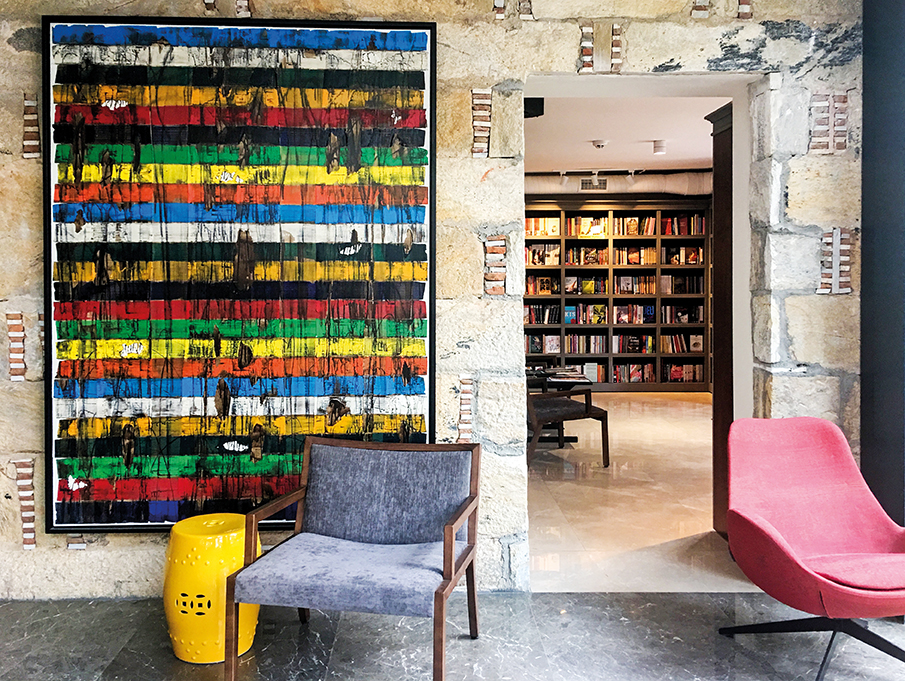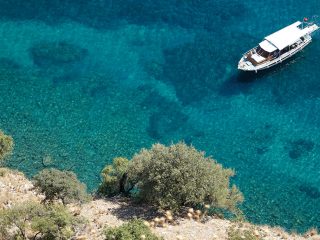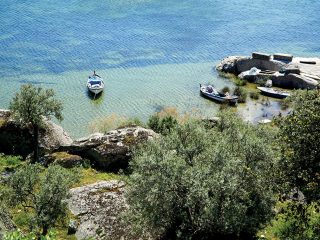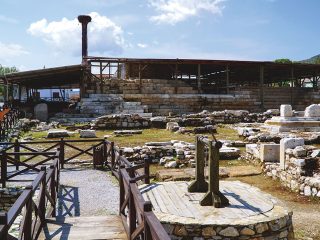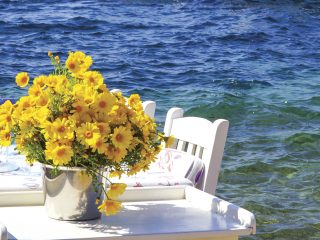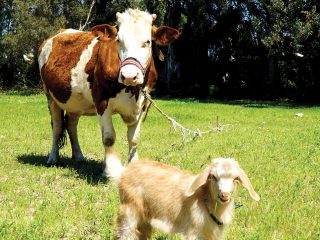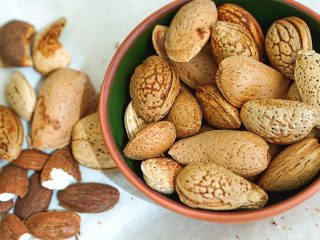With its rich variety of sea life found in caves, reefs, shipwrecks, and even a sunken airplane, the Bodrum peninsula offers an exciting underwater world of adventure and discovery.
By Chris Drum Berkaya
An experienced and well-traveled scuba diver once told me: “The sheer pleasure of a dive in Bodrum’s safe, clear waters, leisurely following a fish along, is one of the most relaxing dive experiences possible.”
This is the essence of diving tourism in Bodrum Peninsula along with a variety of dive sites, experienced and licensed dive instructors, comfortable dive boats, and historical connections to sponge-diving and underwater archaeology heritage.
Turkish diving sites have been regulated since the early 1980s with the input of the researchers based at the Bodrum Museum of Underwater Archaeology. Coastal surveys showed that, in order to protect historical wrecks and coastal sites, only some areas could be opened up to sports diving.
There are 20-25 sites commonly used by dive boats in the permitted recreational diving zone that stretches between Orak Island and the western rocky Kargı islets. Featuring reefs, walls, caves—and even three purposely sunk wrecks— some dive sites are suitable for beginners, while others are only for experienced divers.
Most diving is centered around Karaada, or Black Island, lying to the east of Bodrum. The tree and maquis-covered island is a large natural reserve with bays and coves offering swimming spots for day cruise boats. Certain bays are left to the dive operators. While a good range of small fish can be seen, sometimes—if you are lucky!—stingrays, turtles, or dolphins pass by.
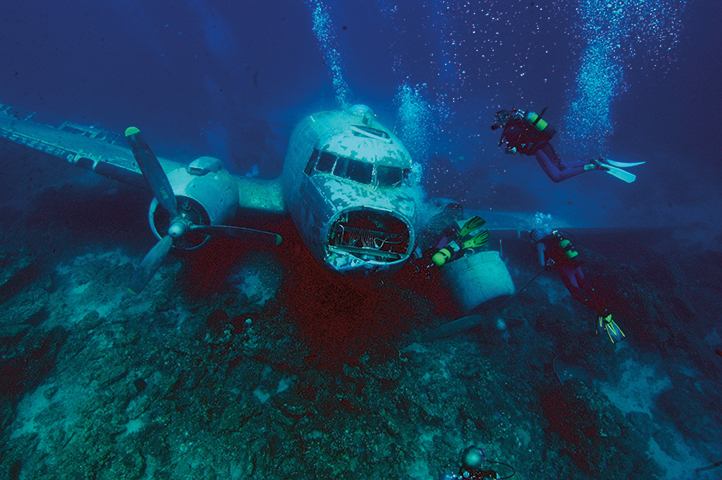
Kaçakçı (Smuggler’s) Bay at the rear of the island offers a good dive for beginners to advanced divers alike, at depths of five to 30 meters where amphorae, octopuses, stingrays, moray eels, groupers, and many species of small fish can be seen. At its western point, Lighthouse Bay offers an easy-grade dive from depths of five to 20 meters over a sandy bottom.
The famous Karaada Bubble Cave is a medium-difficulty dive where divers enter the cave at a depth of 12 meters and exit at four meters, amid exhaled bubbles in the cave trying to escape through cracks in the walls.
Sites around Poyraz Bay at the southeastern end of the island include the moving Mustafa Koç memorial site, a five-meter bronze statue, placed there three years ago following the untimely death of the renowned businessman.
Three wrecks were sunk off Karaada in 2006-2007 after a campaign by Bodrum dive operators to improve diving tourism:
- The 29-meter-long, 17-meterhigh ex-coast guard patrol ship SG115 offers an easy-grade dive at depths of 18-26 meters. Expect to see octopuses and large groupers.
- The 37-meter-long, 18-meterhigh ex-Turkish Navy water tanker PINAR 1 sits at a depth of 36 meters. It offers a dive for advanced divers only. It is possible to enter the wheelhouse where the wheel remains in place, offering excellent photography opportunities. Expect to see nudibranchs, octopuses, squid, and moray eels.
- The ex-Turkish Air Force parachute DAKOTA C47 plane wreck lies askew with wing tips at depths of 17 and 25 meters, and tail at a 28 meter depth. This is an easy-to-medium-grade dive.
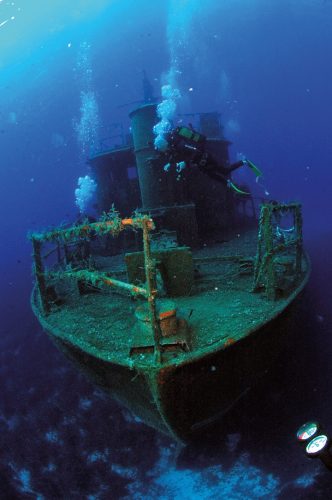
Before arriving at the island, dive boats will often stop halfway across the bay from Bodrum at the popular reefs, imaginatively named the Big and Small Reefs. Both may have currents around them, so are not for beginners, with dives at depths of between five and 35 meters. Divers hope to see larger sea life such as scorpionfish, groupers, tuna, barracudas, and moray eels.
On the headland between Bodrum and Gümbet is Wolf Point, a medium-difficulty site with depths between five and 30 meters. It is favored by photographers for its amphorae, barracudas, and a car wreck.
The most westerly site—rarely visited except by Bitez-based dive boats—is Kargı Island. This is a difficult-grade dive in a strong current at depths of five to 30 meters, and a 35-meterdeep reef nearby.
To the east, past Yalıçiftlik, is Orak Island. Underwater canyons close to the rocky shore offer spectacular wall dives down to 90 meterdepths and a cave. They were sites for past freediving record attempts.
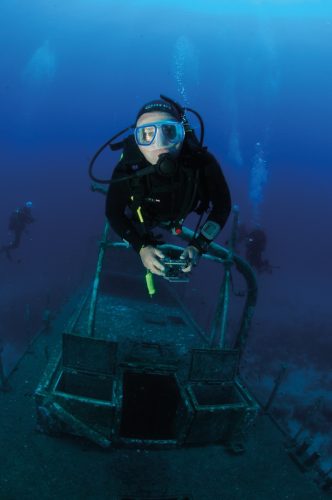
Getting certified
Diving certification is a selfregulated international industry, and the main organizations are PADI (Professional Association of Diving Instructors); SSI (Scuba Schools International); CMAS (Confédération Mondiale des Activités Subaquatiques); and NAUI (National Association of Underwater Instructors). Instructors must be licensed by one of these major organizations and also hold a Turkish Dive license, registration for a dive operator business, and a Turkish Dive Guide license.
- ‘Discovery Dive’ is the introductory dive for the complete novice who can swim. In Bodrum it might include a full day out on the boat, including one assisted dive preceded by a briefing on equipment and procedures. It should be in shallow water on a one-to-one basis with your own personal certified instructor to ensure your safety and comfort. Get your participation certificate afterwards. The price should include full equipment, tuition, one dive, and—if on a boat for the full day—lunch, and swimming/ snorkelling/sunbathing time while the experienced divers continue in groups.
- The PADI Open Water Diver course claims to be “the world’s most popular scuba course and has introduced millions of people to the adventurous diving lifestyle.” There are equivalents under the other international diver certification programs. Usually it comprises a four-day course including instruction, textbook/video theory lessons, pool/confinedwater and open-water training, all equipment usage, lunch, and an internationally recognized certification card mailed later from the PADI or program headquarters.
- The PADI Advanced Open Water Diver course can follow straight after the Open Water Diver certification, teaching specialist diving skills. A deep dive and a compass navigation dive are the two core requirements, along with three other options that can include wreck diving and night diving. The course includes full tuition above and below the water, all equipment, lunch on board, and an internationally recognized certification card from PADI.
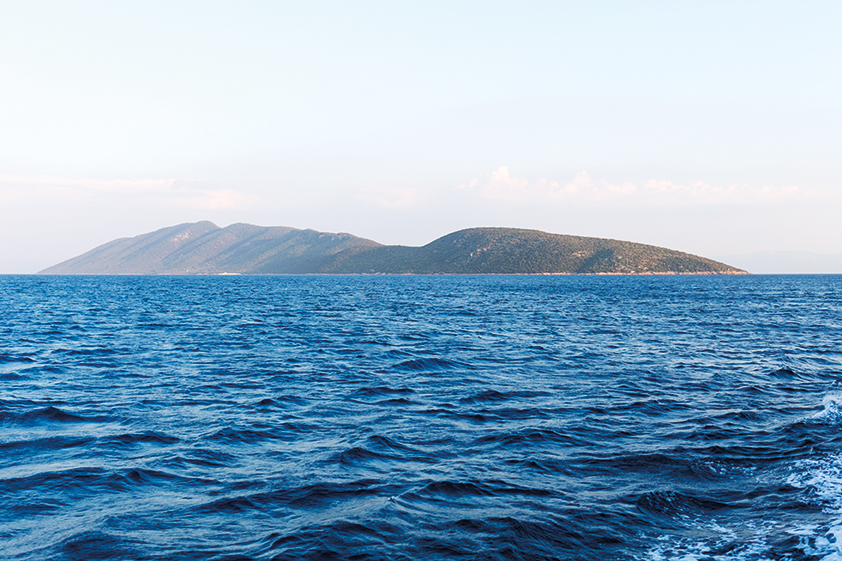
Dive operations
Foreign divers who want a private dive must still dive with a registered operator and a licensed Turkish Dive Guide. Private boats may come alongside a dive boat operator at pre-arranged times or you can book a boat.
- Aegean Pro Dive – Under new owners Emre Taşkınoğlu and partners (after being run for 24 years by Murat and Brenda İçel, who founded the company). Their dive boat ‘Isis’ is based at WOW Hotel, and they offer Scooter Dive&Ride tours around the Karaada wrecks. Adnan Menderes Caddesi No.63, Bodrum; T: 0252 316 07 37; www.aegeanprodive.net
- Aquapro – Founded by Kenan and Joby Doğan in 1997, and uses a boat named ‘Vertigo’. Joby is Bodrum’s first Rebreather Dive Instructor; the equipment extends dive time up to three hours underwater and eliminates bubble noise. “Then the fish don’t get scared away!” says Joby. Bitez; T: 0532 394 91 65; www.aquapro-turkey.com
- Aşkın Diving – Established in 1987 by one of the original Turkish underwater archaeologists Aşkın Cambazoğlu, who dives with his son Tunç. Halikarnas Jetty, Kumbahçe, Bodrum; T:0533 615 90 72; www.askindivingbodrum.com
- Barakuda – Istanbul couple Dilek and Mete Tüneri bought the vintage archaeological surveying and excavation ship ‘Virazon’ in 2017. Bitez; T: 0532 447 03 42; www.barakudabodrum.com
- Blue Escape Diving – Based with the Blue Escape boat at Bodrum Bay resort, between Gümbet and Bodrum. Konacık Mahallesi, Atatürk Bulvarı Pamir İş Merkezi No.114, Bodrum; T: 0537 406 32 84; www.blueescapediving.com
- Dive Academy Bodrum – With 25 years of diving experience along the Turkish coast, Tolga Dokumacı leads his team on the boat he bought five years ago, when he came to Bodrum. Kumbahçe Limanı, Halikarnas İskelesi, Kumbahçe, Bodrum; T: 0533 511 31 27; I: @diveacademybodrum
- Erman Dive – Courses from the shore, and access to dive sites around Orak Island and rocky bays near Sea Garden. T: 0532 213 59 89; www.ermandive.com
- Happy Bubbles Diving Centre – Yener and Oktay run the dive boat ‘Selkie’. Club Flora Hotel, Dayılar Sok. No.3, Gümbet; T: 0532 597 73 86; www.happybubbles.com
- Mako Diving – Run by Volkan Korkmaz. Ergün Soykan Caddesi No.2, Bodrum; T: 0532 241 84 89; www.makodivingbodrum.com
- Turkuaz Diving Centre – Run by Nihat Aydın, using the Nimet-S dive boat. Halikarnas İskelesi, Kumbahçe, Bodrum; T: 0533 393 22 69; www.turkuazdivecenter.com



